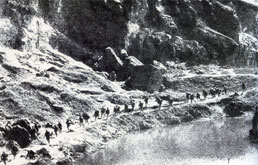Shanxi
The ceded territory became a major problem for the Song dynasty's defense against the Khitans for the next 100 years because it lay south of the Great Wall.[9] The well-preserved city and UNESCO World Heritage Site Pingyao shows many signs of its economic importance during the Qing dynasty.[11] Early in Yan's rule he decided that, unless he was able to modernize and revive the economy of his small, poor, remote province, he would be unable to protect Shanxi from rival warlords.In 1934 the province produced a ten-year-plan that envisaged employing a hygiene worker in every village, but the Japanese invasion in 1937 and the subsequent civil war made it impossible to carry these plans out.[13] Yan invested in Shanxi's industrial infrastructure, and by 1949 the area around Taiyuan was a major national producer of coal, iron, chemicals, and munitions.Yan's army was successful in eradicating banditry in Shanxi, allowing him to maintain a relatively high level of public order and security.[15] He attempted to combat widespread female illiteracy by creating in each district at least one vocational school in which peasant girls could be given a primary-school education and taught domestic skills.[15] After the failed attempt by the Chinese Red Army to establish bases in southern Shanxi in early 1936 Yan became convinced that the Communists were lesser threats to his rule than either the Nationalists or the Japanese.[19] During the Battle of Xinkou, the Chinese defenders resisted the efforts of Japan's elite Itakagi Division for over a month, despite Japanese advantages in artillery and air support.The defenders at Xinkou, realizing that they were in danger of being outflanked, withdrew southward, past Taiyuan, leaving a small force of 6,000 men to hold off the entire Japanese army.Throughout 1937, numerous high-ranking Communist leaders, including Mao Zedong, lavished praise on Yan for waging an uncompromising campaign of resistance against the Japanese.[21] After the surrender of Japan and the end of the Second World War, Yan Xishan was notable for his ability to recruit thousands of Japanese soldiers stationed in northwest Shanxi in 1945, including their commanding officers, into his army.The leader of the Japanese under Yan's command, Hosaku Imamura, committed suicide on the day that Taiyuan fell to Communist forces.Shortly afterwards Republic of China Air Force planes stopped dropping food and supplies for the defenders due to fears of being shot down by the advancing Communists.[24] The fall of Taiyuan was one of the few examples in the Chinese Civil War in which Nationalist forces echoed the defeated Ming loyalists who had, in the 17th century, brought entire cities to ruins resisting the invading Manchus.Liang Huazhi, the head of Yan's "Patriotic Sacrifice League", had fought for years against the Communists in Shanxi until he was finally trapped in the massively fortified city of Taiyuan.For six months Liang put up a fierce resistance, leading both Yan's remaining Republic of China Army forces and his thousands of Japanese mercenaries.In a final act of desperation, Liang set fire to the prison and committed suicide as the entire compound burned to the ground.The Datong (大同), Ningwu (宁武), Xishan (西山), Hedong (河东), Qinshui (沁水), and Huoxi (霍西) coalfields are some of the most important in Shanxi.[citation needed] As part of an effort to promote diversification in non-resource industries, since 2004, some local governments in Shanxi province have required that coal mining companies set aside funds for investing in non-coal business like agriculture and produce processing.[36]: 186–187 There are countless military-related industries in Shanxi due to its geographic location and history as the former base of the Chinese Communist Party and the People's Liberation Army.[citation needed] The revenue of Daqin Railway Co. Ltd. is among the highest among Shanxi companies due to its export of coal to Japan, Korea, and Southeast Asia.[41][42] The central government has responded by increasing oversight, including the suspension of four coal mines in August 2021, as well as ongoing investigations in Shanxi and neighboring Shaanxi.[51] The reports didn't give figures for other types of religion; 82.22% of the population may be either irreligious or involved in worship of nature deities, Buddhism, Confucianism, Taoism, folk religious sects, and small minorities of Muslims.Military police demolished a large Christian church known as Jindengtai ("Golden Lampstand") in Linfen, Shanxi, in early January 2018.It is a breakfast dish; a porridge-like stew made with mutton, Chinese yam (山药), lotus roots, astragalus membranaceus (黄芪; 'membranous milk vetch'), tuber onions, and yellow cooking wine for additional aroma.Puzhou Opera (蒲剧 Puju), from southern Shanxi, is a more ancient type of bangzi that makes use of very wide linear intervals.Shanxi merchants ranged far and wide from Central Asia to the coast of eastern China; by the Qing dynasty they were conducting trade across both sides of the Great Wall.During the late Qing dynasty, a new development occurred: the creation of piaohao (票號), which were essentially banks that provided services like money transfers and transactions, deposits, and loans.After the establishment of the first piaohao in Pingyao, the bankers in Shanxi dominated China's financial market for centuries until the collapse of Qing dynasty and the coming of British banks.






ShaanxiShanxi (disambiguation)ProvinceYanmen PassTayuan TempleHanging TempleDatongWutai MountainNamed forTaihang MountainsTaiyuanprefecturescountiestownshipsParty SecretaryTang DengjieGovernorJin XiangjunNational People's CongressMount WutaiCentral Plains MandarinJilu MandarinISO 3166 codeChinesePostal(Taihang) MountainsStandard MandarinHanyu PinyinBopomofoWade–Gilesother MandarinXiao'erjingSuzhouneseYue: CantoneseYale RomanizationJyutpingSouthern MinHokkienTâi-lôNorth ChinaChangzhistate of JinSpring and Autumn periodInner MongoliaJin Chinesecoal in ChinaTaiyuan Satellite Launch CenterSong dynastyYungang GrottoesWarring States periodstate of QinQin dynastyHan dynastyBingzhouSixteen KingdomsLater ZhaoFormer YanFormer QinLater YanNorthern WeiXianbeiTang dynastyHédōngEmpress Wu ZetianFive Dynasties and Ten Kingdoms periodjiedushiLi CunxuLater LiangLater TangShi JingtangLater JinLiu ZhiyuanLater HanKhitansLater ZhouLiu ChongNorthern HanSixteen Prefectures of YanyunGreat WallGuo WeiShatuo TurksNorthern Song dynastyLiao dynastySouthern Song dynastyJurchenJin dynasty (1115–1234)Jingkang IncidentJin-Song warsMongolYuan dynastyMing dynastyQing dynastyHohhotEight BannersbannerShanxi merchantsWorld Heritage SitePingyaoYan Xishanwarlordcollapse of the Qing dynastyRepublic of ChinaMainland ChinaChinese Communist PartyNationalist governmentbubonic plaguebacteriologyobstetricspublic healthpublic educationJapanese invasion in 1937civil warNational Revolutionary ArmyKuomintangwomen's rightsfoot bindinglunar calendarboy scout organizationsChinese Red ArmyUnited FrontMarco Polo Bridge IncidentImperial Japanese Armed ForcesImperial Japanese ArmyZhu DeEighth Route ArmyPingxing Pass